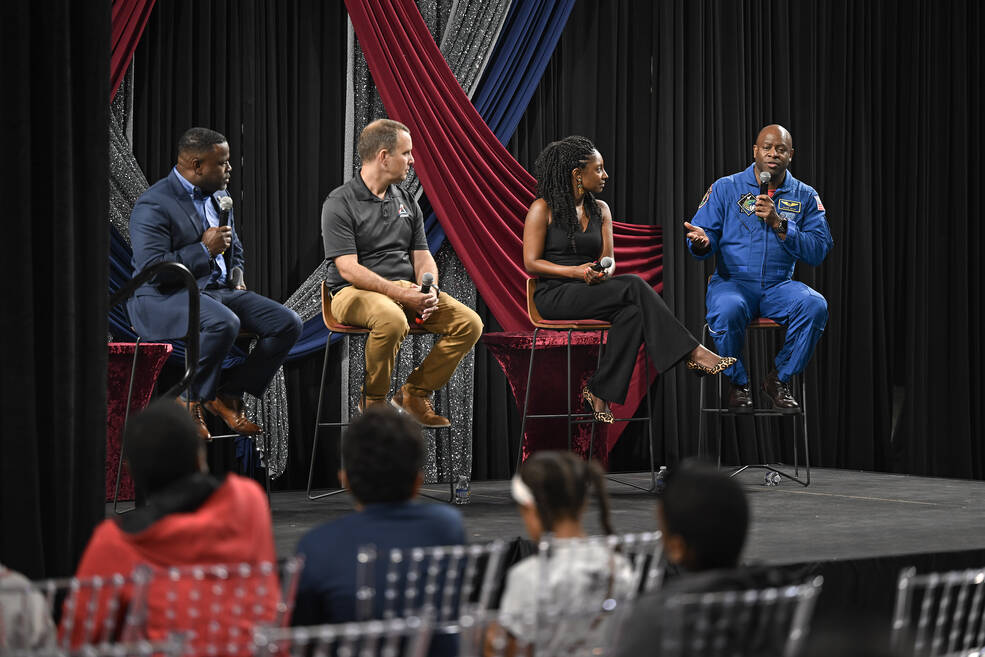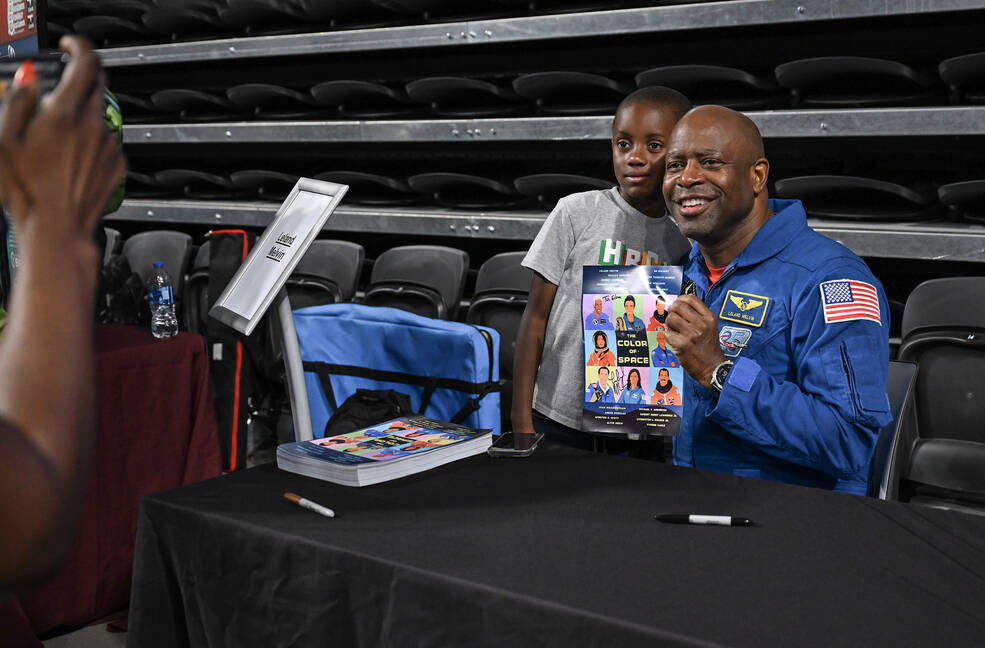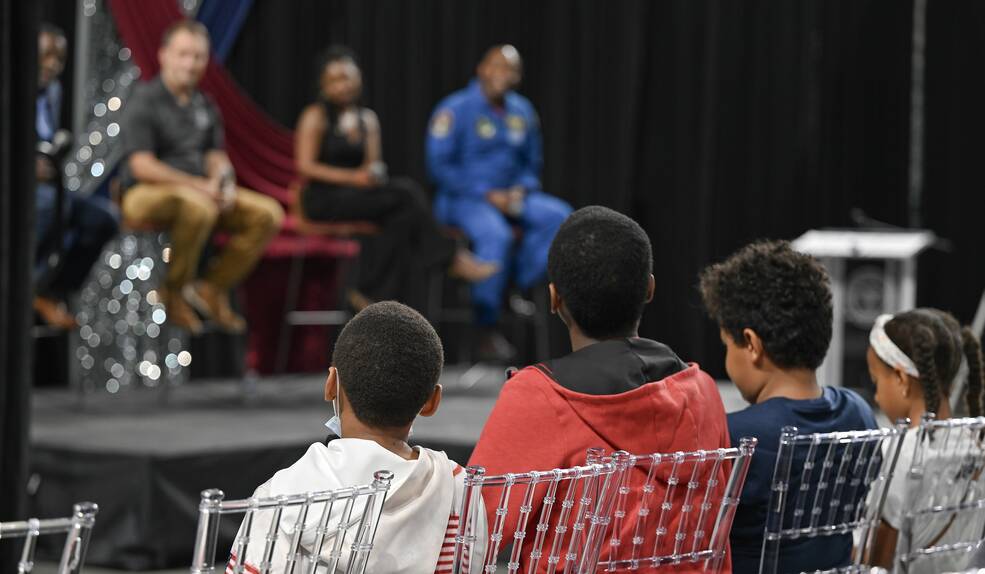As NASA prepares to land the first person of color on the surface of the Moon through its Artemis missions, a new documentary explores the many contributions Black Americans have made to the space program.
By Wayne Smith
There’s space for everyone as NASA continues to explore the secrets of the universe for the benefit of humanity.
That was one of many key messages shared with students and others attending a special screening of NASA’s The Color of Space documentary film on Sept. 8 at Alabama Agricultural and Mechanical University in Huntsville, Alabama. As NASA prepares to land the first person of color on the surface of the Moon through its Artemis missions, the documentary explores the many contributions Black Americans have made to the space program.

A crowd of more than 100 – including students, alumni, faculty, staff, and community members – attended the screening, held at the Alabama A&M Event Center. A panel discussion followed the 50-minute documentary. Retired NASA astronaut Leland Melvin, who is featured in the documentary, attended and joined in the panel discussion.
“This film serves as a powerful reminder of the progress made and the journey still ahead,” Melvin said. “My sincere hope is that The Color of Space will inspire future generations to never give up on their dreams and to always know that they belong.”

NASA’s Office of STEM Engagement and Office of Communications at the agency’s Marshall Space Flight Center in Huntsville, Alabama, partnered with Alabama A&M on the screening. Several OSTEM engagements took place in coordination with the screening, including recruiting for internships, according to Kevin McGhaw, director of NASA’s Office of STEM Engagement – Southeast Region. McGhaw moderated the panel discussion, which included Melvin, NASA chief historian Brian Odom, and Jori Kates, producer and director of the film for the agency.
“Representation matters and opportunities like this screening reinforce our agency’s ongoing efforts to build a STEM pipeline from the talent pool at HBCUs (Historically Black Colleges and Universities), and other minority serving institutions,” McGhaw said.
Bringing diverse perspectives to NASA is necessary for our space exploration mission’s success.

Kevin McGhaw
Director of NASA’s Office of STEM Engagement – Southeast Region
NASA and Club for the Future, a nonprofit founded by Blue Origin have hosted multiple free in-person viewing events nationwide of the documentary at HBCUs, conferences, festivals, and more.
The Color of Space captures the personal stories of seven current and former Black astronauts, each selected to become part of NASA’s astronaut corps and train for space missions. Current NASA astronauts Stephanie Wilson, Victor Glover, Jeanette Epps, as well as retired astronauts Leland Melvin, Bernard Harris, Robert Curbeam, and Bobby Satcher, speak about their journeys and their motivations in a panel hosted by NASA Johnson Space Center Director Vanessa Wyche, the first Black woman to lead a NASA center. They took the step to achieve the impossible, overcoming barriers and making space for others to follow. In this new documentary, be empowered by the remarkable stories of tenacity, courage, and motivation from the agency’s most decorated heroes. Learn about their path to NASA, their sources of inspiration, experiences in space, the importance of representation, the meaning of Juneteenth, and much more. Originally held at Space Center Houston on March 25, the panel discussion marks the first time the seven astronauts have been assembled for an official NASA event.Credits: NASA
The documentary highlights a conversation between current NASA astronauts Stephanie Wilson, Victor Glover, Jeanette Epps, as well as retired astronauts Leland Melvin, Bernard Harris, Robert Curbeam, and Bobby Satcher, speaking about their journeys and motivations in a panel hosted at NASA’s Johnson Space Center by its director, Vanessa Wyche, the first Black woman to lead a NASA center.
The Color of Space also includes rare archival footage and interviews with Guion ‘Guy’ Bluford, the first Black man in space; Charlie Bolden, retired astronaut and first Black NASA administrator; former astronauts Alvin Drew and Joan Higginbotham; and Ed Dwight, America’s first African American astronaut candidate.
Kates said she is honored to have been able to help share the incredible journey of NASA’s Black astronauts. “Their passion and commitment to continuing their legacy and inspiring the next generation of explorers and STEM professionals is truly remarkable as they share their experiences, hopes, and dreams, while acknowledging the weight of their roles as Black men and women,” Kates said.
Melvin concluded the event, specifically addressing the college, high school, and elementary students in attendance about their role in continuing what those who came before them started. “We’re all connected to this legacy, and we need to do our part to be along this same journey to greatness and to excellence, whether it’s building tracker beams, or going on the Moon, to Mars, or beyond,” he said.
Odom said it was befitting that the screening took place at Alabama A&M, given the institution’s long relationship with Marshall.
“It’s a relationship that has included many collaborative efforts and contributions in science and engineering,” Odom said. “One important example was the development of the computer science program in the mid-1960s with the support of Marshall’s African American pioneering mathematician, Clyde Foster.”
Learn more about The Color of Space.
For more on NASA’s Marshall Space Flight Center, visit:
https://www.nasa.gov/centers/marshall/home/index.html
Lance D. Davis
Marshall Space Flight Center, Huntsville, Alabama
256.544.0034
lance.d.davis@nasa.gov



























